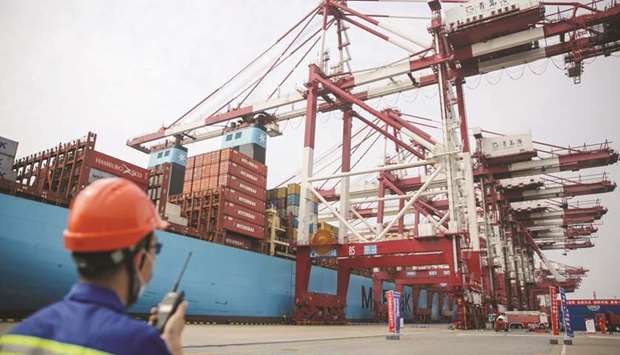China continues to supply evidence that the nation first into the coronavirus crisis will be the first major economy to pull out of it, with data this week set to show an accelerating recovery. Growth in industrial production is forecast to have picked up and retail sales may have stopped shrinking in July in numbers due on Friday. Investment for the first seven months of the year is expected to contract compared with a year earlier, but at a slower pace than in the previous month.
Recent figures including a better-than-expected trade performance are giving policy makers in Beijing enough confidence to start talking about an exit from virus-crisis monetary policy, and the central bank even last week warned of the ongoing risks from low interest rates in developed economies.
Still, consumer confidence remains fragile and susceptible to further virus outbreaks - and China’s industry-led recovery is still at the mercy of global demand and the course of the pandemic. President Xi Jinping is also, amid the rising tensions with the US, talking more about the need to be self sufficient in key industries.
“A China data blitz should show the economic recovery making further progress in July, supported by firmer consumer demand, a pickup in production and letup in factory deflation. The details will help assess the durability of momentum. Credit expansion may have slowed on a seasonal downturn in lending”, says Bloomberg economist.”
China’s economic pickup coincides with rising tensions with the US. Senior officials from the two nations are planning to assess the so-called phase-one trade deal on or around August 15, six months after the agreement took effect, according to people briefed on the matter. At the same time, the Trump administration last week moved to ban US residents from doing business with the Chinese-owned TikTok and WeChat apps, an attempt to curb China’s power in global technology.
US: US jobless claims data on Thursday will show whether job losses extended their decline. Friday will bring July figures on retail sales and industrial production, as well as preliminary consumer sentiment for August, providing a key sign of whether the economy can continue to recover amid the pandemic.
Asia: New Zealand’s success in eliminating the coronavirus has enabled the closed-border economy to rebound, but central bank chief Adrian Orr will want to avoid any hint of hawkishness when he sets interest rates on Wednesday for fear of setting off any further appreciation of the currency.
Australian jobs data for July will be closely watched on Thursday as a spreading outbreak in Melbourne weighs on the nation’s recovery prospects.
Europe, Middle East, Africa: After a disappointing rebound in May, all eyes will be on whether the UK’s economic bounce-back from the depth of the recession gathered momentum in the following month. Another lackluster figure would raise expectations of an imminent monetary stimulus by the Bank of England. The quarterly reading will still show that the economy suffered a major blow, with output potentially shrinking more than 20%.
GDP readings are also due for the Netherlands, Finland, Denmark and in economies across eastern Europe including Russia, Poland and Ukraine.
Turkey, where the lira has sunk to a record low and revived talk of interest-rate increases, publishes data on unemployment on Monday, and on the current-account balance and expected inflation over the next 12 months on Friday.
On the central bank front, Uganda could hold interest rates on Monday after inflation quickened to an almost three-year high in July and Serbia meets on Thursday.
Latin America: On Tuesday in Brazil, the minutes of last week’s central bank meeting may offer added guidance on what lies ahead now that the key rate is at a record-low 2%.
On Thursday, Mexico’s central bank will cut its key rate for a 10th straight meeting to as low as 4.5% with the economy mired in the deepest recession since the 1930s. Later in the day, Peru’s central bank will keep its key rate at a record-low 0.25%. The bank hasn’t ruled out further easing.
Data for June’s Brazil retail sales and Mexico industrial output should show some month-on-month improvement. On Friday, Colombia’s second-quarter GDP report will be unambiguous: the economy hit historic lows in the April-June period.

A staff member working at a port in Qingdao in China’s eastern Shandong province. China continues to supply evidence that the nation first into the coronavirus crisis will be the first major economy to pull out of it, with data this week set to show an accelerating recovery.
